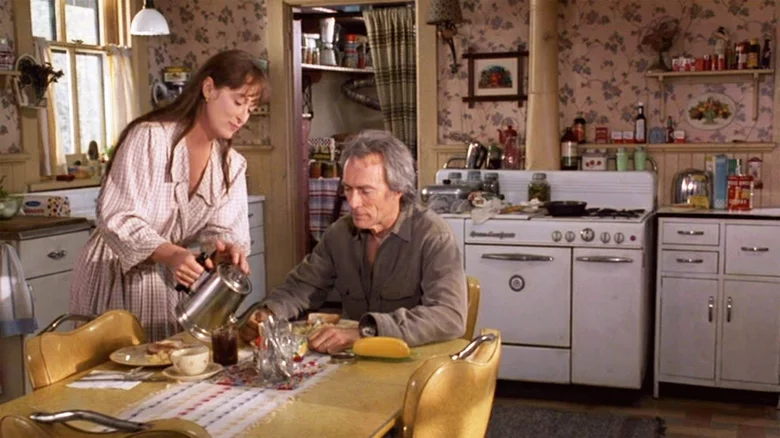Clint Eastwood’s quiet romance “The Bridges of Madison County” was released in June of 1995, right into the middle of a busy summer blockbuster season that included “Casper,” “Braveheart,” “Johnny Mnemonic,” and would soon go up against “Congo” and “Batman Forever.” Eastwood’s film, made for a modest $22 million, was counterprogramming for every one of those films, offering a calm, mature romance among the typical summer movie thrills and violence. “Bridges” was also unusual in that it also starred Eastwood, already in his mid-60s, as a romantic lead.
Prior to the original book’s publication in 1992, it had already attracted the attention of Amblin Entertainment, who had bought the film rights the year previous. “Bridges” immediately went on a long production journey, being passed from director to director and from screenwriter to screenwriter, hoping to quickly find purchase. According to Entertainment Weekly, Sydney Pollock was once offered the project, although he would step out. There was even buzz that Spielberg himself (working on “Schindler’s List” at the time) would step in to direct, so moved was he by a screenplay draft written by Richard LaGravenese. That version never manifested.
According to a 1995 making-of article in Entertainment Weekly, Eastwood — who had long ago signed on to play the film’s co-lead — was getting antsy. Time was passing, and “Bridges” started slowly moving toward the dreaded Hollywood back burner. The story goes that Eastwood called Warner Bros. chair Terry Semel saying “Everyone is going to move on to something else.” In a fit of diplomacy, Semel suggested: “How about you directing it.”
In characteristic fashion, the no-nonsense Eastwood barked back “Give me 24 hours.”
Give me 24 hours

The story goes that Eastwood, in that 24 hours, hopped on a Warner Bros. jet and flew to Iowa where “Bridges” takes place. He scouted several locations, and even located a photogenic bridge that would serve as the film’s central, titular location. In finding an existing bridge — saving the studio the hassle of having to build one — Eastwood immediately reduced the film’s budget by $1.5 million. He called up Semel and agreed to direct. Evidently, Warner Bros. was so impressed by Eastwood’s expediency that they more or less gave him wide berth. Eastwood proceeded to make “The Bridges of Madison County” exactly the way he wanted.
The film is about a lonely housewife named Francesca (Meryl Streep) living in a rural area of Iowa in 1965. Her husband and two teen children have left on a vacation, leaving her bored and alone to reflect on the sad state of her marriage. Into her life comes a National Geographic photographer named Robert (Eastwood) who aims to photograph the bridges of Madison County. The two of them fall deeply in love and have a passionate affair. It’s so passionate, in fact, that Francesca is sorely tempted to leave her husband and children for Robert. Ultimately, she is adult enough to understand that a passionate affair wouldn’t necessarily make for a good long-term relationship and she goes back to her husband. She and Robert carry torches for one another until their deaths.
After her death, Francesca’s children are taken aback to find that she wants her ashes scattered from a particular bridge rather than her body be buried next to her husband. Her request will be — through plot details I shall not reveal— related to her undying love for Robert.
An adult story

Anyone who has seen “The Bridges of Madison County” can speak to its calm tone, its sunny authentic exteriors, and its languid pace. Eastwood saw the story as being about adults in isolation. There are many scenes of Robert and Francesca wandering through the whispering grasses, looking over brooks, gazing at bridges. Their passion grows from their isolation and a mutual recognition of each other’s lonesomeness. It helps that the characters are not young or given to quick sexual impulses; they do a great deal more internal emotional consideration when it comes to their affair. Ultimately, their maturity will play an important role in their decisions; both characters are wise enough to know what an affair means, and how impractical leaving one’s life behind can be, even if that life is an unhappy one.
Eastwood’s control of the project was vital to getting it made. In the Entertainment Weekly article, the film’s composer Lennie Niehaus talked about how Eastwood took over, saying simply that “Clint has a way of taking something and making it his own.” The film was, as mentioned, a hit at the box office, and well-received by critics; it currently holds a 90% approval rating on Rotten Tomatoes, inspiring critics to remark on the film’s staid, observational qualities. Richard Corliss, in Time Magazine, pointed out that “where the book ogles, the film discreetly observes,” calling the central romance “a dance of appraisal.” In a summer of explosions for kids, here was a film that was steadfastly for adults.
The film was Eastwood’s 19th as a director, and showed that he was relaxing from muscular genre films into moodier, more thoughtful films. Eastwood has largely been in that mold ever since.
